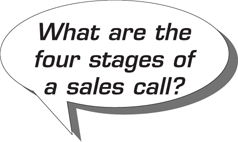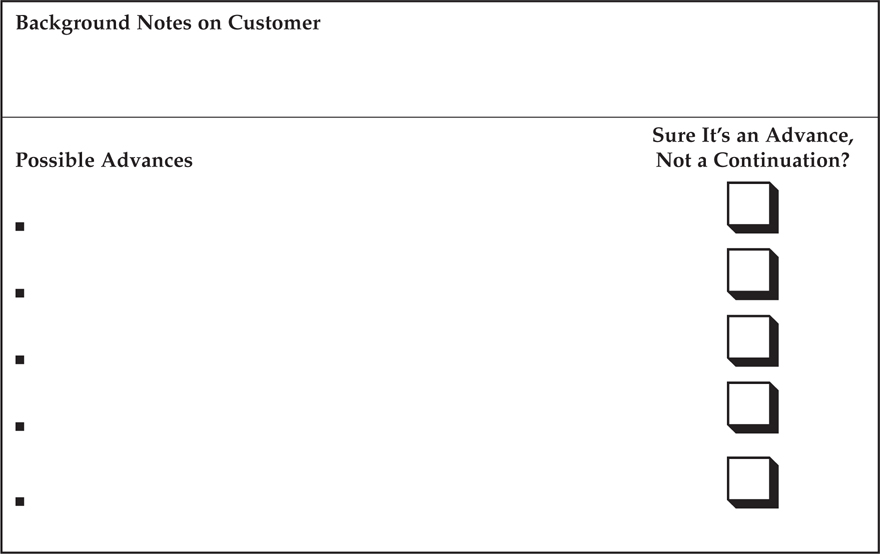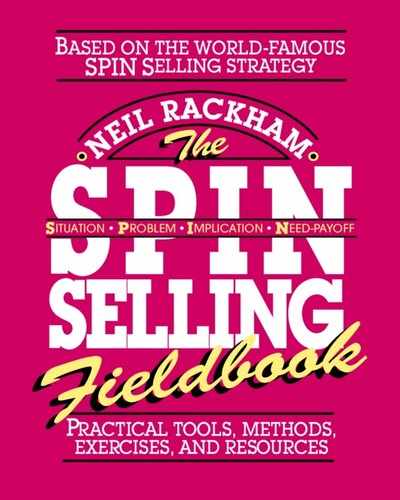4
Four Stages of a Sales Call

Overview

1. Opening—the preliminaries, including introductions and beginning the conversation.
2. Investigating—uncovering, clarifying, and developing the buyer’s needs.
3. Demonstrating Capability—establishing how your solution meets buyer needs.
4. Obtaining Commitment—securing agreement to an action that moves the sale forward toward purchase.
Research evidence shows that the Investigating stage is the most crucial to success in large or complex sales.

Almost all sales, from the simplest to the most sophisticated, go through the same four stages, leading to the same ultimate results or outcomes:
![]() An Order or win—where there is a commitment to buy.
An Order or win—where there is a commitment to buy.
![]() A No-sale or loss—where there is a refusal to buy.
A No-sale or loss—where there is a refusal to buy.
But in large or complex sales calls, because of the time required to complete the sale, there may also be two other interim outcomes:
![]() An Advance—where there is buyer agreement on an action that moves the sale forward.
An Advance—where there is buyer agreement on an action that moves the sale forward.
![]() A Continuation—where there is no buyer agreement on an action that would move the sale forward.
A Continuation—where there is no buyer agreement on an action that would move the sale forward.

So, in large or complex sales:
![]() The whole cycle usually requires multiple calls.
The whole cycle usually requires multiple calls.
![]() Success in Obtaining Commitment depends on skillfully conducting the Investigating stage.
Success in Obtaining Commitment depends on skillfully conducting the Investigating stage.
![]() It’s crucial to set realistic call objectives and achieve call outcomes that actively move the sale forward.
It’s crucial to set realistic call objectives and achieve call outcomes that actively move the sale forward.
The Most Important Stage in a Sale
Research, including the SPIN® research, shows that Investigating is the most important stage of the sale. However, for generations the traditional wisdom didn’t acknowledge the importance of Investigating. Many sales managers swore that Obtaining Commitment—“closing”—had to be most important.
In small sales, there is some evidence to suggest that “if you can’t close, you can’t sell.” But in large and complex sales, success depends, more than anything else, on the skills used by the seller in the Investigating stage.
What exactly is Investigating? In a sales context, Investigating means systematically discovering, exploring, clarifying, and understanding the buyer’s business needs and problems. And to investigate, you must ask questions.
Questions, Questions, All Kinds of Questions
Questions are the most effective form of verbal behavior you can use to persuade. And that’s not just in selling. Multiple research studies have overwhelmingly shown that more questions are asked in successful negotiations, management interactions, performance interviews, group discussions, and other interactions than in unsuccessful ones.
Huthwaite’s research went further. We examined scientifically, for example, the standard assumption that “open” questions are better for selling than “closed” questions. First, let’s define each:
![]() Closed questions can be answered with a single word, often “yes” or “no.”
Closed questions can be answered with a single word, often “yes” or “no.”
![]() Open questions require longer, more descriptive answers, often taking the form of “Could you tell me something about …?” or “Why is that important to you …?”
Open questions require longer, more descriptive answers, often taking the form of “Could you tell me something about …?” or “Why is that important to you …?”
Since open questions get the buyer talking, conventional wisdom has been that there ought to be a connection to successful selling. Our studies found, however, that there is no link between whether questions are open or closed and successful selling.
But we did find that certain other kinds of questions are linked directly to successful selling when asked in a particular sequence. As we’ve seen, those are the SPIN® questions.
Why the Investigating Stage Is So Important
People purchase something to meet needs or resolve problems. They decide to buy when the pain of the problem and desire for a solution have been built to the point where they are greater than the cost of the solution. And it’s the Investigating stage where SPIN® questions are used to help you to uncover and develop your buyer’s problems.
Opening the Call
In larger sales, less is known about the Opening stage of the call than the other stages for a simple reason: Most larger sales involve existing customers or clients, where buyers and sellers are already acquainted. Less than 5 percent of meetings that major account sellers have are first calls with new customers, but some research data does exist for these kinds of Openings.
The book SPIN® Selling describes how and why certain traditional methods for opening a call may work in small sales but don’t for larger sales (pages 137–143). One such approach is the use of an “opening benefits statement.” In this approach, the seller opens with a statement about how the product or service could help the buyer. In very brief calls, that are less than 10 minutes long, an opening benefits statement may help engage the buyer’s interest in your product or service. But in longer calls—and an average business-to-business sales call lasts 40 minutes—there is no link between the success of the sale and using an opening benefits statement. In fact, it can be risky.
Don’t Introduce Your Solution Too Soon!
One of the biggest traps inexperienced sellers fall into is introducing their solution too early. It’s so tempting and so common that we’ll caution you frequently about it. What our research has repeatedly shown is that successful sellers don’t talk about their products, services, or the benefits of their solution until late in the sales call.
Since making an opening benefit statement is an early (very early!) way of introducing your product or service, it is very likely to sabotage your call. Why? Because:
![]() It forces the seller to talk about product or service details before building value.
It forces the seller to talk about product or service details before building value.
![]() It allows the buyer to ask the questions and take control of the discussion.
It allows the buyer to ask the questions and take control of the discussion.
The Purpose of Opening
The purpose of Opening is to gain the buyer’s agreement for you to ask questions—to move on to the Investigating stage.
A good opening should establish a buyer-centered purpose. What does this mean? It means focusing on the buyer’s concerns, rather than on your product or service. It also means being flexible—considering factors such as who set up the meeting, how well you know the client or customer, and what time constraints exist.
Although you also need to communicate who you are and why you’re there (not by giving details of your product or service), as well as to establish a basis for asking your SPIN® questions, it’s important to stay focused on the buyer’s concerns, rather than your own needs. Being buyer-centered helps establish trust and receptivity, and builds your credibility.
Opening Your Calls Effectively
1. Get down to business quickly. While you need to respect the norms of the organization and culture, a greater danger is wasting the time of a busy executive. As a general rule, spend as little time as necessary on the Opening.
2. Don’t talk about solutions too soon. Using an opening benefits statement is an example of prematurely introducing your solution. It’s crucial to develop the buyer’s needs and build value before you offer a solution or talk about your capabilities. Talking about solutions too soon causes objections and reduces the likelihood of a sale.
3. Concentrate on questions. Don’t worry too much about appearing smooth or polished in the preliminaries of the call. Plan some appropriate questions ahead of the meeting and use the time in the Opening stage to gain the buyer’s consent to move forward to the Investigating stage. If you find that the buyer is asking the questions—that you’re being asked for facts and explanations—you’ll need to vary the way you open calls to establish your role as questioner during this stage.
It will help if you practice doing 30-second openings until you’re confident you’ve covered the key points without sounding “automatic.” The best test of whether you’re being effective in the Opening stage is how readily the buyer becomes receptive to answering your questions.
The SPIN® Questions and the Investigating Stage
Since the Investigating stage has the most impact on the buyer’s decision to purchase your product or service, using the SPIN® questions effectively is, as you’ll see, the core of successful face-to-face selling. The next chapters will show you how to use SPIN® questions during the Investigating stage to uncover, clarify, and develop buyer needs.
Demonstrating Capability
Sooner or later you have to demonstrate that you have a solution that can help solve the buyer’s problems. You can use a variety of methods to demonstrate the value of your solution, but what may work in simple sales won’t work as the size or complexity of the sale increases. One example is that in large sales, introducing your solution later is clearly more effective than doing it sooner. Chapter 10 covers how Need-payoff Questions are used during this stage to help the buyer identify the benefits and, by extension, the value of your solution. Chapter 11 is devoted to Demonstrating Capability.
Obtaining Commitment
When SPIN® Selling was first published, common wisdom held strongly that Obtaining Commitment—closing—was the most important stage of a sale. Chapter 2 of that book describes the struggles we went through to show conclusively that the traditional wisdom about the importance of closing was just plain wrong.
In large or complex sales, what is most important is how sellers handle the Investigating stage.
SPIN® Selling has helped people understand how traditional closing techniques are indeed ineffective or have a negative impact when:
![]() The sale is large or complex, or when it involves high-value goods or services.
The sale is large or complex, or when it involves high-value goods or services.
![]() Selling to a sophisticated customer or client—for example, a professional buyer.
Selling to a sophisticated customer or client—for example, a professional buyer.
![]() There is a continuing relationship after the sale.
There is a continuing relationship after the sale.
SPIN® Selling not only points out the dangers of closing; it also points out that you must still obtain some kind of commitment from the buyer, or you won’t have a sale. In a simple sale, either you get a commitment to buy, an Order, or the prospect refuses to buy and you have a No-sale. Either way, it’s relatively easy and quick to tell if you have a successful sale. But larger, complex sales are very different. In larger sales the key is to obtain the right commitment.
Obtaining the RIGHT Commitment
Large sales can involve many individual calls and sometimes take years to complete. In major account sales, fewer than 10 percent of calls actually result in an Order or a No-sale. With neither an outright rejection or a contract in hand, how can you tell if a call is successful? What other call outcomes might define success versus failure in large or complex sales?
The starting point for Obtaining Commitment in these kinds of sales is determining the level of commitment that would make the call a success.
Call Outcomes
In simple sales, there are really just two possible call outcomes: You get either an Order or a No-sale. Large or complex sales are different. It may take months or years to get the Order. So you need to be able to identify other successful and unsuccessful call outcomes along the way.
In large sales, if an individual call results in an action that moves you closer to a sale—what we call an Advance—it is a successful outcome. The key measure is getting buyer agreement on an action that moves you toward the sale. The “action” may be taken by either the buyer or the seller. But a buyer action always makes a clearer and stronger Advance, because it shows the buyer’s commitment to moving the sale forward, e.g., the buyer agrees to attend a demo or arrange a meeting for the seller with other decision makers. A buyer’s request for a proposal would not be a clear Advance unless the buyer also agrees to take some action that moves the sale forward, such as reviewing the selection criteria before you write the proposal or discussing a draft proposal before final submission.
The outcome of a call that does not reach agreement on action that moves the sale forward—a Continuation—is unsuccessful, no matter how pleasant or complimentary the buyer seems.
Obtaining Commitment—a Summary
Top sellers close more calls, more effectively, by:
![]() Turning Continuations into Advances.
Turning Continuations into Advances.
![]() Understanding what kind of Advance can make the call successful.
Understanding what kind of Advance can make the call successful.
![]() Setting realistic closing objectives that move the sale forward.
Setting realistic closing objectives that move the sale forward.
Planning Advances
Top sellers reach their ultimate goals by consistently planning and conducting calls that move the sale forward in steps. What exactly do they do? They start by brainstorming to identify the widest variety of Advances that would move them toward a sale. Really skilled sellers then select those ingenious small actions that the buyer is likely to agree to. Having determined an array of useful Advances, the seller is ready to set a realistic call objective, but will have alternative actions to propose as needed for the actual visit. This approach increases the likelihood that the visit will result in an Advance.
Example
Less successful sellers get more Continuations, where skilled sellers get Advances. How does that happen?
Many less successful salespeople are content with objectives like “collect info about the customer,” “build rapport with the buyer,” or “get buyer to say they like our system.” There’s nothing wrong with objectives like this. It’s always good to find out more and build relationships. But, by themselves, objectives like these don’t have action that moves the sale forward. They’re Continuations. Selling requires more. It needs action—an Advance—to move the sale forward.
Practice Brainstorming Possible Advances
1. Select a customer or client of yours that you are scheduled to visit in the next couple of weeks.
2. Based on the current stage you are in of the sales cycle, and using your existing knowledge of your buyer’s needs, brainstorm potential Advances. Go for quantity and variety. Include as many actions as possible that, if agreed to by the buyer, could move the sale forward.

3. List the possible Advances you come up with in the following space:
4. Check each Advance to make sure it has a forward action. Otherwise it’s just a Continuation.
5. Choose the Advance that involves the highest realistic action you think you can achieve. Make this the Call Objective for your visit. Highlight some fallback alternatives to offer as needed.
6. After the visit, review the actual call outcome. Did you get the Advance?
CHECK YOURSELF—CALL OUTCOMES
Are you clear about the possible call outcomes? Try to identify each of the following as either an Order/Sale, Advance, Continuation, or No-sale.
Call Outcome
1. ![]()
2. ![]()
3. ![]()
4. ![]()
5. 
6. ![]()
7. 
8. 
9. ![]()
Answers are on the next page.
CALL OUTCOMES—ANSWERS
1. Sale If the buyer is prepared to complete the paperwork, there’s not much doubt you’ve won the order.
2. No-sale The client or customer has given you a clear statement that they are not buying from you.
3. Continuation It’s certainly nice of the buyer to say those things. But because there’s no action involved that might progress the sale, this can only be a Continuation.
4. Continuation Agreement to another meeting by itself, with no action, just continues the sale, rather than moving it toward a decision to buy. If, for example, the person added, “I’ll bring one of the other vice-presidents from the selection committee,” then this would be an Advance.
5. Advance There is an action, a meeting with the partner, which advances the sale toward a decision to buy.
6. Continuation The door isn’t closed, but it could be a typical brush-off to get rid of the seller without actually saying “no sale.” “Thinking about it” in this case is not an action, and does not progress the sale.
7. Advance Here the buyer is proposing two actions: one for the seller (to include items in the proposal) and one for the buyer (to present the proposal to associates).
8. Advance This is not an Order or sale, nor is it a “99 percent definite” kind of promise. Unless there’s an unshakable commitment to sign, you should downgrade this kind of statement to an Advance.
9. Advance The buyer is proposing three actions. In this case, the seller’s action is to arrange a demo/site visit, and the buyer’s two actions are to attend the demo and bring the production manager.


